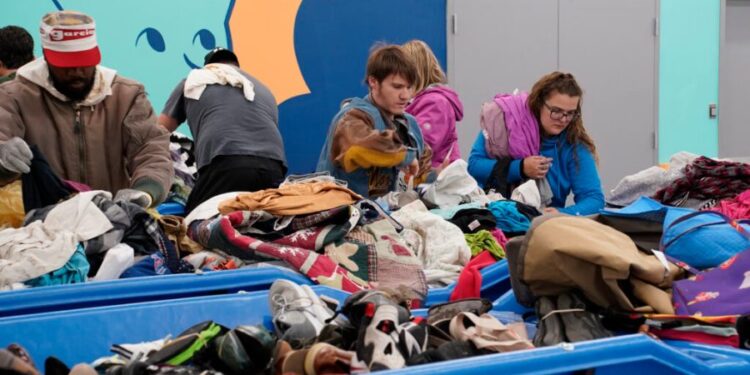On a recent Saturday morning, dozens of people lined up, many wearing plastic gloves with carts nearby, waiting to begin. Yellow barriers were placed around the area to keep people back. Everyone took their positions. Then all at once, they made a run for it.
But this wasn’t a marathon or any other kind of traditional race.
It was all for the bins. And we had a front-row seat to watch it all.
On a busy stretch of San Fernando Road in Los Angeles, in a nondescript area lined with fast-food restaurants and commercial businesses, sits the Goodwill Retail Store.

By now, you’ve seen them – looking much more upscale than the retail centers you may have seen years ago. They can compete with the likes of Ross or Marshalls on appearance: neat, organized, and bargains hidden in the racks.
But these shoppers weren’t there for the retail store.
In an attached warehouse space, just to the left, sits the Goodwill Donation Center. Within those walls was the outlet: a hidden free-for-all thrifting superstore where stuff comes right off the trucks and into the bins—huge bins to be picked over by shrewd bargain-hunters.
Here, they charge by the pound—$3.19 per pound of clothing and $1.19 per pound of home goods—regardless of what you find. And it is very competitive.
The Goodwill site itself says, “When preparing to visit the blue bins, brace yourself for a rough experience, including shoving and aggressive re-sellers and vintage hunters.”
That’s an understatement.
We witnessed people armed with carts and bags, working in teams, ready to muscle their way to the front. Don’t try to snag someone’s cart – and don’t try to cut in front of them.
Security was there to keep the peace and ensure the workers could access the blue bins without any problems.
Just what are they selling there?
“The Goodwill Bins in California are known for their competitive and intense atmosphere, but it’s worth it. Surrounded by affluent cities, these outlets often yield treasures like vintage clothing, electronics, and high-end dishware,” the nonprofit says.
We found plenty of treasures: Ed Hardy clothing, Super Mario, Star Wars—things people would want (and plenty they might not). These items could likely fetch good money on eBay, Facebook Marketplace or Craigslist.
So how do those items end up in the blue bins?
Marla Eby at Goodwill tells KTLA 5 News that saleable donations are first offered at the retail stores. Items that don’t sell in retail are sent to the blue bins, and items that don’t make it in the blue bins are sent to commodity brokers.
All of it could be yours – if you’re ready to do battle.
Thrifting is big business.
According to Capital One shopping research, 1.4 billion second-hand apparel items were purchased in the U.S. in 2022, up a staggering 40% since 2021.
The secondhand market is currently estimated at $43 billion dollars and rising fast.
There are many simple reasons for this. Most notably, who doesn’t want a good deal?
Plus, resale is a little like recycling and keeps stuff out of landfills. However, saving money is the biggest reason some 85% of thrifters say they are digging into thrifting.
What does KTLA consumer expert David Lazarus think?
“This isn’t for everyone. So-called super thrifting turns clothes shopping into a gladiatorial contest, and that’s a turn-off for many people,” Lazarus said. “But for those with sharp elbows, an aggressive attitude, and plenty of patience, this can be a great way to score deals on discarded designer duds and gadgets.”
On that Saturday morning in Los Angeles, it was clear: the big blue bins had people seeing green and prepared to become garment gladiators.
California has 17 Goodwill outlets, and Goodwill Southern California currently runs three outlets with the Bins:
- Los Angeles – 3150 N. San Fernando Road, Los Angeles 90065
- San Fernando Valley – 14565 Lanark St. Panorama City 91402
- San Bernardino – 8120 Plan Lane, San Bernardino 92402






